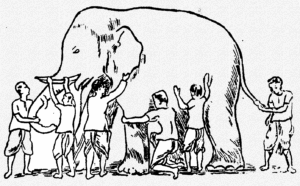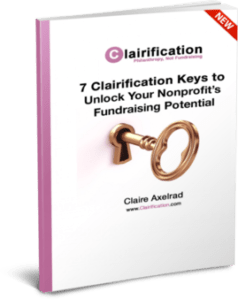
It takes a village to tell the whole story
A recent article on Beth’s (Kanter) Blog by Miriam Brosseau and Stephanie Corleto was so well-written I was inspired to share some of it with you. I 100% agree with everything it says – and strongly believe you absolutely must do what the article suggests.
What’s that?
Bust down your siloes!
Specifically, turn those puppies on their sides so they form a pipeline, and let the free flow of ideas between programs, marketing and fundraising begin.
Can you picture this?
Imagine your program staff is hoarding all the inspiring stories of impact, and failing to share them with your development team. That’s a silo that needs to be toppled. Because… how can you hope to persuade folks of the relevance and purpose of your mission, values and vision absent those compelling stories?
Program staff too often believe this information should remain private, and “our clients shouldn’t have to become ‘poster children’ for the sake of fundraising.”
The problem with this perspective is the view of ‘fundraising’ as dirty and shameful. It’s not. It’s a privilege you earn when you’re successful in fulfilling your mission. And, when folks come to rely on you, fundraising becomes a responsibility you must fulfill so you don’t leave these beneficiaries high and dry.
Okay. Back to Miriam and Stephanie’s article. It grabbed me from the get-go with this line I wish I’d written:
“Silos are for corn. Stories are for people.”
Corny, but apt.
The idea is that rather than storing up a bunch of proprietary data and skill sets in separate containers (aka departments), why not focus on shared stories instead?
Use a storytelling lens, rather than a staff expertise lens.
Don’t assign marketing staff to tell one story, development staff to tell another, and volunteer managers to tell yet another. That’s like the parable of the blind men and the elephant who describe what they perceive (through touch) based on their partial experience, and their descriptions are in complete disagreement on what an elephant is. Rather, why not bring everybody in your organization together to tell your story in the most absorbing way possible?
That means telling your story once. Holistically. Compellingly. Not in bits and pieces through multiple mailings, emails or social media posts sent from different silos. Each with a different agenda (e.g., seeking volunteers; seeking attendees; seeking donors; seeking clients).
Your target market is one person. With one agenda: What’s in this for me?
If a prospective donor receives multiple messages from you in the same week, or even same day, they’re apt to get a bit peeved. Indeed, what’s in it for them to have to sift through your inconsistent messages and piece them together? Or figure out which calls to action they should prioritize?
What do you most want them to do? Volunteer? Attend an event? Complete a survey? Sign a petition? Support the ABC program as opposed to the XYZ program?
Too often messages originating from different silos are conflicting and competing. It looks like the right hand doesn’t know what the left is doing. That disturbs your would-be donor, rather than inspiring them.
Figure out, as an organization, what one thing you want your audience to do at any point in time; then go for it. Don’t make them have to decide between your competing demands for their attention.
Stories have unparalelled power to draw people in.
We’re all story people. Stories are the oldest form of human communication – before writing! We’re wired to understand the world through stories. If you can’t engage your audiences through storytelling, whatever you’re trying to accomplish will wither and die. You have to believe in the power of shared stories to make them work their magic on your organization’s behalf!
Even if your message doesn’t start out as a story, find one to tell. Often this takes a village. Development staff don’t always have easy access to stories. Nor do marketing staff. And even when they manage to unearth stories by interviewing program staff, some of the pieces may be missing to create a donor-centered experience.
True Story: When I started out in fundraising, I used to sit down with program staff and ask them to give me what we called a “case vignette.” They’d tell me a lot of reasons why their client needed help. Then they’d tell me a lot of services we provided. And then… I’d ask”: “Was there a happy ending?” “What would a happy ending look like?” That’s what I needed to convey to prospective donors. And you know what? The staff I was interviewing weren’t even thinking about the situation as being a story at all! Once I explained, however, they completely understood and were able to offer up all sorts of great ideas.This is where developing a storytelling, story-sharing culture can make a huge difference.
Because you need to wrap your message in a story your audience will empathize with and find stimulating and relevant. In other words, you need a story that invites your donor to jump in and be the hero who gives the story a happy ending.
A well-told story will influence people to take action.
Why? Because folks will be inexorably drawn into the tale you’re telling. They’ll want to become a part of it — in a ‘force for good’ way.
You get them to see a role for themselves by using language your constituents can understand, and using traditional storytelling formatting. Make the transitions between parts of your story easy to recognize so folks can easily be transported on a journey – the last part of which is taking the plunge to become an integral part of the unfolding narrative.
Stories are the foundation of a strong brand.
They demonstrate who you are (your identity, essence, or raison d’etre), and are imbued with your vision, mission and values. The best ones not only help people to see themselves in your story, they also move them to share your story with others – spreading inspiration.
Click here to read the full article from Miriam and Stephanie. They offer useful tips for developing a storytelling culture, which is the sine qua non of busting down silos and becoming donor-centric rather than ego-centric. You can have the best strategies in the world, but you know what they say?
When all is said and done, culture eats strategy for breakfast.
Want to ‘Clairify’ Your Organization’s Stories, Brand and More?

Tips, tools, templates, exercises, worksheets and checklists galore!
You may be interested in this SPECIAL GUIDE: 7 CLAIRIFICATION KEYS TO UNLOCK YOUR NONPROFIT’S FUNDRAISING POTENTIAL Through a series of ‘clairifying’ worksheets and individual and group exercises, this 23-page guide will give you fresh insights into: (1) Values. (2) Stories. (3) Brand. (4) Social Channels. (5) Support Constituencies. (6) Engagement Objectives. (7) Resources and Systems. It comes with the standard Clairification a 30-day, no-questions-asked, money-back guarantee. So… you really can’t lose!






Awesome share. Thanks for this blog.